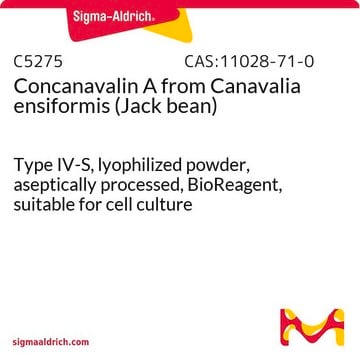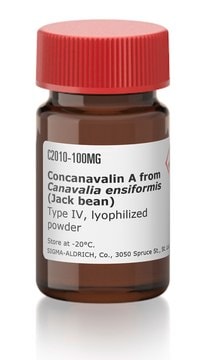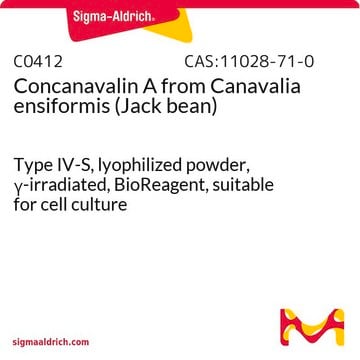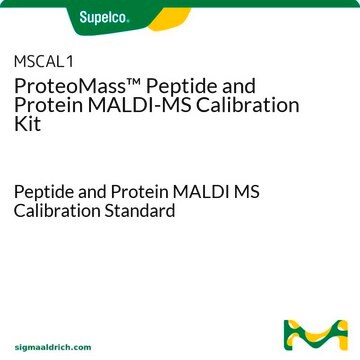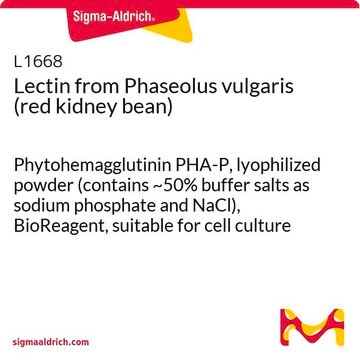α-Cyano-4-hydroxycinnamic acid (α-CCA, α-CHCA, α-Cyano, 4-HCCA, ACCA) is soluble in methanol (up to 50 mg/ml). It is also soluble at 10 mg/ml using 50% acetonitrile in 0.05% TFA for MALDI-MS. The acetonitrile concentration can be adjusted for individual preferences.For biological applications, it has been solubilized at 100 mM in DMSO or 50 mM in ethanol.
Kluczowe dokumenty
C8982
α-Cyano-4-hydroxycinnamic acid
suitable for MALDI-TOF MS
Synonim(y):
α-CCA, α-CHCA, α-Cyano, 4-HCCA, ACCA
Wybierz wielkość
1290,00 zł
Wybierz wielkość
About This Item
1290,00 zł
Polecane produkty
Formularz
powder
klasy chemiczne analitów
glycans, peptides, proteins
mp
245-250 °C (lit.)
przydatność
suitable for MALDI-TOF MS
temp. przechowywania
room temp
ciąg SMILES
OC(=O)\C(=C\c1ccc(O)cc1)C#N
InChI
1S/C10H7NO3/c11-6-8(10(13)14)5-7-1-3-9(12)4-2-7/h1-5,12H,(H,13,14)/b8-5+
Klucz InChI
AFVLVVWMAFSXCK-VMPITWQZSA-N
Szukasz podobnych produktów? Odwiedź Przewodnik dotyczący porównywania produktów
Opis ogólny
It is also available as part of our ProteoMass™ MALDI calibration kits (MS-CAL1 and MS-CAL3).
Zastosowanie
Opakowanie
Informacje prawne
produkt powiązany
Hasło ostrzegawcze
Warning
Zwroty wskazujące rodzaj zagrożenia
Zwroty wskazujące środki ostrożności
Klasyfikacja zagrożeń
Skin Sens. 1B
Kod klasy składowania
11 - Combustible Solids
Klasa zagrożenia wodnego (WGK)
WGK 3
Temperatura zapłonu (°F)
Not applicable
Temperatura zapłonu (°C)
Not applicable
Środki ochrony indywidualnej
dust mask type N95 (US), Eyeshields, Gloves
Wybierz jedną z najnowszych wersji:
Certyfikaty analizy (CoA)
Nie widzisz odpowiedniej wersji?
Jeśli potrzebujesz konkretnej wersji, możesz wyszukać konkretny certyfikat według numeru partii lub serii.
Masz już ten produkt?
Dokumenty związane z niedawno zakupionymi produktami zostały zamieszczone w Bibliotece dokumentów.
Klienci oglądali również te produkty
Protokoły
Explore mass spectrometry analysis of glycans for glycomic & glycoproteomic neutral & acidic glycan analysis. See a general mass spec glycan analysis procedure.
-
What can be used for solublization of α-Cyano-4-hydroxycinnamic acid?
1 answer-
Helpful?
-
-
What is the Department of Transportation shipping information for this product?
1 answer-
Transportation information can be found in Section 14 of the product's (M)SDS.To access the shipping information for this material, use the link on the product detail page for the product.
Helpful?
-
Active Filters
Nasz zespół naukowców ma doświadczenie we wszystkich obszarach badań, w tym w naukach przyrodniczych, materiałoznawstwie, syntezie chemicznej, chromatografii, analityce i wielu innych dziedzinach.
Skontaktuj się z zespołem ds. pomocy technicznej